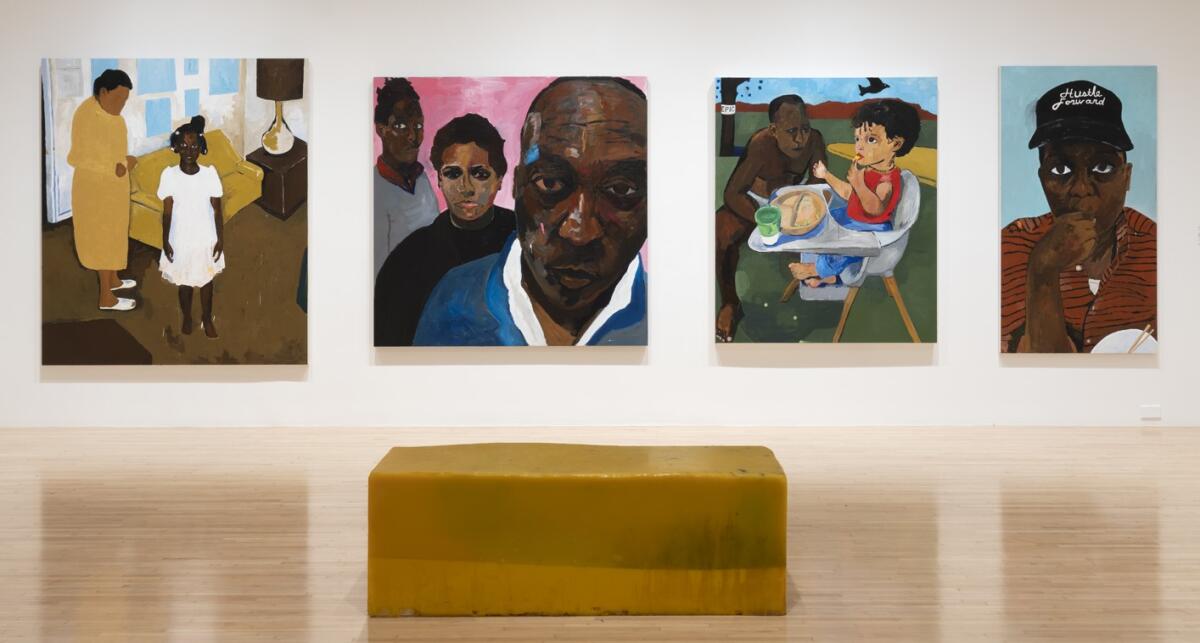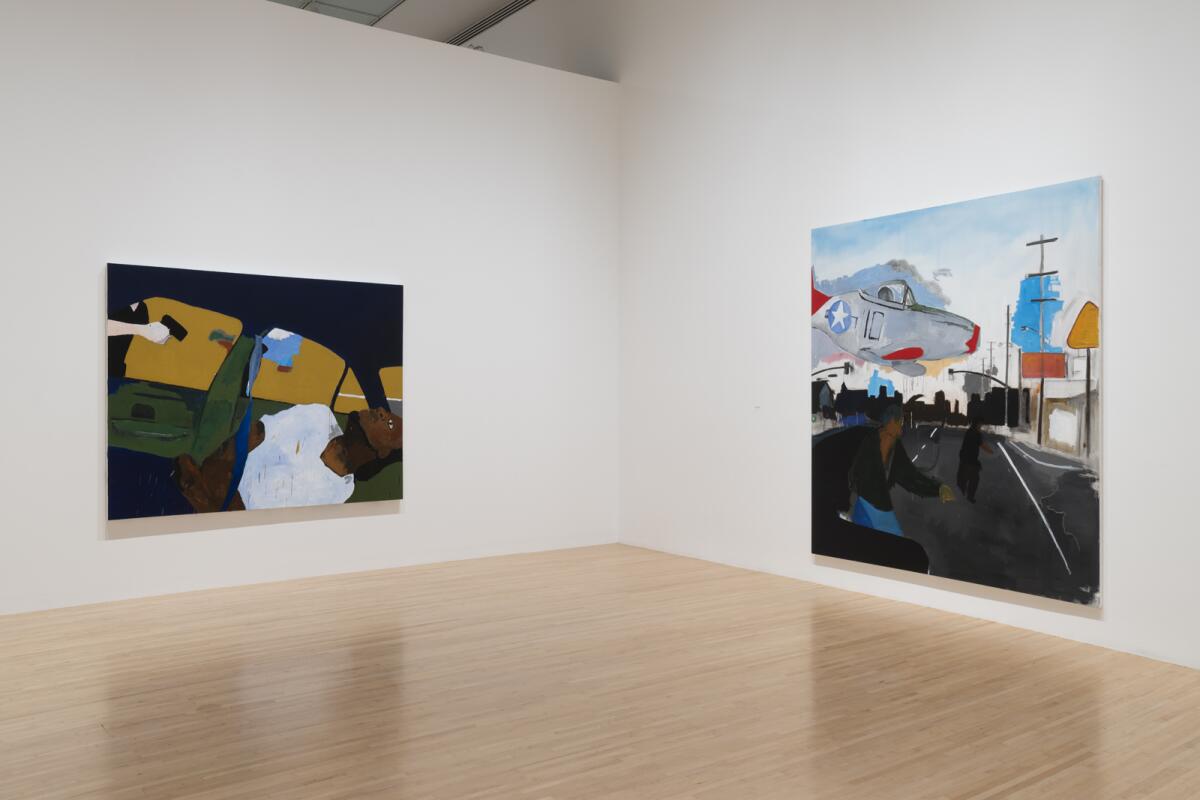A vital MOCA retrospective centers L.A. painter Henry Taylor’s unforgettable art

- Share via
Henry Taylor is an activist painter.
Not an “action painter,” that quaint term for a 1950s Abstract Expressionist of the New York School. As “Henry Taylor: B Side” — the big, brash, vital retrospective exhibition at the Museum of Contemporary Art — so plainly demonstrates, Taylor has other objectives in mind.
For one thing, Taylor paints figures. He’s a genre painter, creating images of daily life — mostly friends and family, but also historical people, folks on the street, here and there a famous person and occasionally even himself. Sometimes daily life is joyful, sometimes cruel.
For another, he was born in Ventura (in 1958). Los Angeles is the city where he lives and works.
More to the point, while loose, brushy, sometimes energetic paint-handling is on vibrant display, as it was in the Ab Ex heyday, the way he puts that technique to work is what matters most. Taylor pumps life into the static picture plane, which creates a visual friction that can make the figures he chooses riveting to see.
His activism is based in representation, but it extends beyond a simple accumulation of faces, most of them Black, not often embodied in the history of American painting. Take his nearly life-size 2013 portrait of Steve Cannon (1935-2019), one of many standouts among the nearly 90 paintings from the last 30 years in the show.

Cannon, an eminent writer, founded A Gathering of the Tribes, a well-known multicultural literary magazine that emphasized Black writers and artists in the 1990s, before morphing into an exhibition and general cultural organization on Manhattan’s Lower East Side. Taylor depicts Cannon seated, but — notably — he sits in a pool of green paint rather than a chair.
The canvas is split in two, the dividing line cutting across Cannon’s body at the waist. The ground above is variegated brownish grays, brushed in broad strokes wet-on-wet, while below a liquid field of green is muddied with dribbles of brown. Like his crossed legs, Cannon’s head and upper torso are framed in flickering swipes of green, as if this is a depiction of a holy man surrounded by an incandescent aureole. Patches of exposed white canvas add to the general glow.
Cannon’s head is slightly lowered; apparently, he’s reading something unseen in his lap (his eyes are shaded behind sunglasses). His right hand is hidden behind his knee, sensible for holding an unseen book, while the left hand is held at his jaw, where a pinky finger brushes his lips.
In one of the more disconcertingly inventive (but effective) passages, one that recalls many of Willem de Kooning’s iconic paintings of women, the writer has no feet. The dark blue pants — jeans? — on the crossed legs of his flatly rendered clothing just abruptly end. Taylor visually suspends his figure within the space of painting, constructed as a sensuous field of scrutiny and contemplation.
In short: The artist’s composition reflects exactly what the subject is himself engaged in doing. Cannon is concentrating, engaged with art, lost in thought. And that’s what we’re doing too, checking out Taylor’s painting. Artist, sitter, viewer — we’re all in it together.
A viewer gets slyly connected to the art, where “reading” its visual language becomes dynamic participation in the genre scene of daily life being represented. Whether we know who Steve Cannon is or not is secondary. That identification is gravy. Taylor has said he’s not really a portrait painter, and when you spend some time with his work you can see why. He approaches painting as a social endeavor — active representation, not passive, which portraiture usually demands.

“Henry Taylor: B Side,” which travels to the Whitney Museum of American Art next year, was organized by MOCA senior curator Bennett Simpson, with curatorial assistant Anastasia Kahn. Rather than shown chronologically, the work is loosely grouped by theme, including street life in downtown L.A., riffs on art history, social justice issues and more.
A few sculptures and installations are included, but they’re less engaging. Taylor is plainly a painter. The most effective installation features images.
A grid of photocopies of formal portraits of Black men and women killed by police or vigilantes is a veritable homemade shrine, with spaces on the wall marked by the legend “Miss U” and a handprint. Written in reserved but determined pencil within one prominent blank space is a name for a missing photo: “Emmett was here — no, is.” The reference to Emmett Till, and the anti-sensational deference in not reproducing his 1955 picture laid out brutalized in a casket, conjures a historic photograph that continues to haunt American life.
Taylor is a genre painter for whom art is itself integral to ordinary existence. As he gathers scenes of everyday life, motifs vary widely.
Our portrait of the artist: Taylor, subject of a sweeping retrospective, paints luminaries and the homeless in pieces that tweak politics and history.
A Black man on the grass in a leafy park — and incongruously wearing a suit — throws a football high in the air, four Black kids surrounding him and three white kids in the distance all looking on expectantly. A grinning, grandmotherly type poses as if for a friendly cellphone snapshot, a cheery bulldog yapping at her feet and a grandfatherly type sitting quietly in a room behind her. A voluptuous naked woman lolls on a Victorian sofa, a witty glimpse of a black cat disappearing behind the furniture. A young woman draped in pearl necklaces looks up from texting on her phone, catching your eye.
Taylor’s scenes of everyday life perform what might be called stop-motion image-making. Formal stasis presses against visible paint handling. The picture sticks in your brain, while your body responds to the painterly scene. Sometimes the subject is grim, which adds to the impact.
“The Times Thay Aint A Changing, Fast Enough!” doesn’t name Philando Castile, notoriously shot to death by a policeman during a questionable traffic stop in St. Paul, Minn. So fresh is the tragedy that titling it so is hardly necessary.

To frame his eight-foot-wide composition, Taylor climbs inside the car, the spot where Castile’s girlfriend, Diamond Reynolds, and her young daughter had witnessed the killing in close-up horror. Now we do too, in ways different from seeing what a cellphone can capture.
A man’s body lies back, one visible eye open and immobilized. Acrylic paint-drips, their colors encompassing much of the picture’s entire palette, rain down like spattered blood on the figure’s white T-shirt. A seat belt’s vertical blue shoulder strap splits the canvas in two, twisting in space like a strand of DNA.
On the right side is the Black corpse, on the left a clumsy off-white hand outside the vehicle holding a silhouetted weapon. Rather than faithful realist depiction, the gun’s boxy black shape, aimed at the prone body, smartly opts for blunt expressive power. Outside the car windows, the landscape is mostly a flat, airless field of noxious mustard color — it too drips down onto the T-shirt — a triangular glimpse of blue sky and a passing cloud poking up like a distant mountaintop.
The Castile painting is dated 2017, the year after the shooting occurred, but in sync with the time of the trial and the policeman’s acquittal. If a plain stylistic comparison is to be made with other figurative art, Richard Diebenkorn’s figurative Berkeley years from the late 1950s is apt. But Taylor’s aim — his activism — is entirely different.
The powerful liveliness of his painting grinds against the deadliness of the awful event. Creation slams against destruction, italicizing both. Like many others in this show, the canvas is unforgettable.
'Henry Taylor: B-Side'
Where: MOCA Grand Avenue, 250 South Grand Avenue
When: Tuesdays, Wednesdays and Fridays 11 am-5 pm; Thursdays 11 am-8 pm; Saturdays and Sundays 11 am-6 pm
Info: 213-626-6222, moca.org
More to Read
The biggest entertainment stories
Get our big stories about Hollywood, film, television, music, arts, culture and more right in your inbox as soon as they publish.
You may occasionally receive promotional content from the Los Angeles Times.












